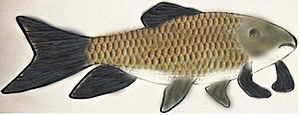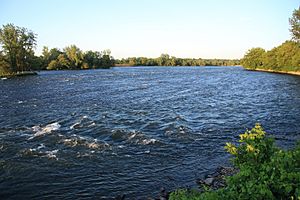Copper redhorse facts for kids
Quick facts for kids Copper redhorse |
|
|---|---|
 |
|
| Conservation status | |
| Scientific classification |
The copper redhorse (Moxostoma hubbsi) is a special type of freshwater fish found only in Canada. It belongs to the family Catostomidae, which are often called "suckers" because of their mouth shape.
This fish lives in only a few rivers in southwestern Quebec. Sadly, its home has gotten much smaller over the years. Today, you can mostly find copper redhorse in parts of the St. Lawrence and Richelieu rivers. Some might still live in the Rivière des Mille Îles.
The copper redhorse was first officially described in 1952 by Vianney Legendre. However, it seems to have been known even earlier, with mentions dating back to 1866 by Pierre Fortin. It's one of seven similar fish species in Canada that are part of the Moxostoma group.
Contents
Where Does the Copper Redhorse Live?

The copper redhorse likes to live in medium-sized rivers. The water in these rivers usually gets warmer than 20 °C (about 68 °F) in the summer.
When it's time to lay eggs (this is called spawning), they look for certain spots. These spots are usually areas with a moderate to slow current, about 0.75 to 2 meters (2.5 to 6.5 feet) deep. The riverbed there is often made of fine to coarse gravel and small rocks.
Baby copper redhorse, called "young-of-the-year," spend their first summer in shallow areas. These spots are usually less than 1.5 meters (5 feet) deep. They have gentle slopes, lots of plants, very slow currents, and a soft bottom made of clay, silt, and sand.
So far, only two main spawning areas are known in the Richelieu River. These are near the Chambly archipelago and below the Saint-Ours dam. A special "nursery" area for young fish has also been found near Saint-Marc-sur-Richelieu.
Recently, copper redhorse have also been seen again in the Lavaltrie-Contrecoeur area of the St. Lawrence River. Scientists are still trying to figure out why they are there. It could be for laying eggs, migrating, or spending the winter.
Sadly, good homes for the copper redhorse are becoming harder to find. For example, they seem to have disappeared from the Yamaska and Noire rivers. This is likely because the environment in those rivers has become unhealthy.
How Many Copper Redhorse Are There?
Old records show that there used to be many more copper redhorse. But since the mid-1980s, their numbers have dropped a lot compared to other similar fish.
The fish that are left are getting older, and not enough new baby fish are surviving. In the Richelieu River, where they are known to lay eggs, very few young copper redhorse are found. This means the population is not growing.
Most of the fish caught today are older and larger. There have been almost no young fish (around 2 years old) caught in the last 30 years. Experts believe there are only a few thousand adult copper redhorse left in total.
What Harms the Copper Redhorse?
The copper redhorse has some unique traits that make it special, but also make it vulnerable. For example, they live a long time, start having babies later in life, and have a very specific diet.
The areas where copper redhorse live are also some of the most crowded parts of Quebec. This means human activities play a big role in their decline. It's hard to point to just one problem, as many things work together.
The biggest reasons for their decline are thought to be:
- Habitat loss: Their homes are being damaged or broken up.
- Low spawning success: Not enough baby fish are surviving after the eggs hatch.
Other things that might be hurting them include:
- Pollution: Chemicals and waste in the water.
- Siltation: Too much mud and dirt settling on the riverbed, covering their spawning areas.
- Eutrophication: Too many nutrients in the water, which can cause harmful algae blooms.
- New species: Other fish or plants that are not native to the area can compete with them.
- Dams: These structures block fish from moving freely to their spawning or feeding grounds.
- Disturbance: People or boats disturbing the fish when they are trying to lay eggs.
Why Is This Fish Important?
The copper redhorse is important for more than just science. It also matters for our society, for keeping nature healthy, and for protecting all kinds of living things.
This fish can tell us a lot about how human activities affect the rivers and ecosystems in southern Quebec. If the copper redhorse is struggling, it's a sign that the environment is not healthy.
Many people are interested in this special fish, and that interest continues to grow. Protecting the copper redhorse helps protect the entire river environment for everyone.
See also
 In Spanish: Moxostoma hubbsi para niños
In Spanish: Moxostoma hubbsi para niños


